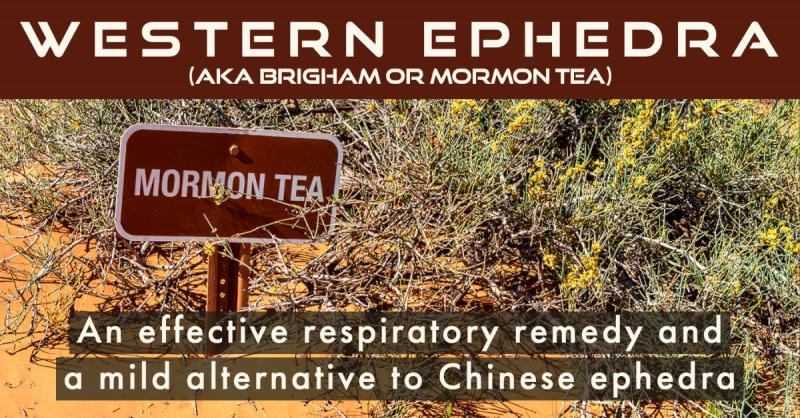
It’s a shame when we lose a valuable medicinal herb because it was abused. Such was the case with Chinese ephedra or ma huang (Ephedra chinensis) which was officially banned for sale in the United States by the FDA twenty years ago. I believe that understanding how and why ma huang was banned really helps clarify the importance between herbal medicine and using herbs as an alternative to medical treatment. And how lucky we are to have a viable, and perhaps even superior remedy still available to us in the Western species of ephedra.
These two species of ephedra grow in the Southwestern United States. One is green ephedra (Ephedra viridis) and the other is most commonly referred to as Brigham or Mormon tea (Ephedra nevadensis). These common names come from the late 1800s when Brigham Young encouraged the Mormon pioneers to drink Western ephedra tea as an alternative to the prohibited coffee and black tea. It's unfortunate that this tea has fallen out of favor because despite my not being a big fan of tea, I actually found that when I gathered them, both Western species made a rather pleasant, mildly stimulating tea with some substantial health benefits.
The Rise and Fall of Chinese Ephedra
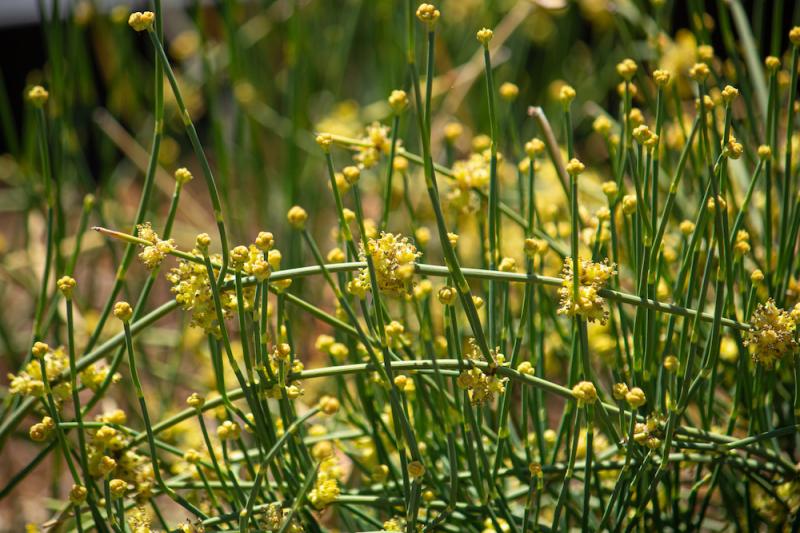
Ma huang (Chinese ephedra) has had a long history of use in TCM for asthma, respiratory congestion, and the treatment of respiratory allergies. But, it is considered to be what is known in TCM as an inferior medicine. This is because it acts as a strong symptom-relieving remedy and not as a slower-acting superior medicine or tonic that helps to restore overall health. In TCM it wasn't used as a single remedy, instead it was combined with gentler-acting tonic remedies. So, you’d get some fast-acting symptomatic relief from the ephedra coupled with more lasting health-building benefits from the other herbs. Had ephedra continued to be used in this way, I don’t think there would have ever been a cause to outlaw it as such use is perfectly safe.
Drug-Like versus Tonic Actions
I believe the problem Chinese ephedra ran into was the fact that Western society is consumed with the idea of the quick fix. An idea that is reflected in both the symptom-relieving focus of Western pharmaceuticals and the drive within the herb industry for standardized extracts, concentrates, and isolates that can be used as alternatives to Western drugs.
Ma haung quickly grew in popularity when it become known in the West because of its strong symptom-relieving actions. And because of its powerful effects and natural origin, it was used in diet pills to stimulate the metabolism for weight loss and was abused as a natural alternative to the class of drugs known as speed. Basically it started being taken in large doses as an upper to get high.
Natural Doesn't Equal Safe
These problems came from the belief that using a symptom-relieving herb like Chinese ephedra, instead of an isolated pharmaceutical, doesn't require thought and consideration. But this isn't the case, natural doesn't equal safe. Product manufacturers abused this belief after researchers discovered that a combination of ephedrine (an alkaloid found in ephedra), caffeine, and aspirin would boost metabolism to help a person lose weight. They started making alternative weight-loss herbal formulas with Chinese ephedra, kola nuts, and willow bark and marketing them as safe and all-natural.
I remember a mother bringing her eight-year-old son to me back in the early 1990s. She had been giving him one of these herbal combinations for weight loss because she thought he was overweight. She brought him in because he was starting to have heart palpitations. I told her that the formula she was giving him was what was causing his heart palpitations, but she refused to believe me. She said the formula was all-natural and therefore couldn’t have any negative or dangerous side effects.
Why We Lost Chinese Ephedra
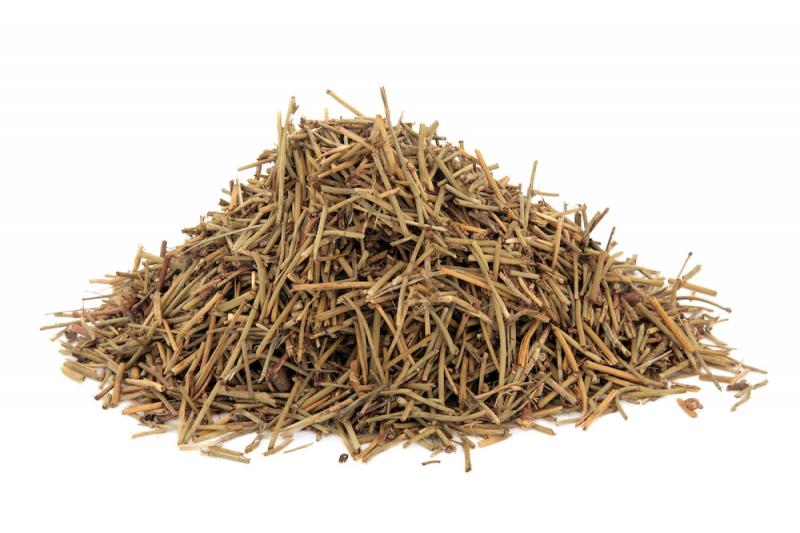
I believe the attitude that because something is natural it is safe is what led us to lose Chinese ephedra. Strong herbs like ephedra are safe only when we use them properly. In the West, ephedra was used for things that it had never been used for in TCM, such as weight loss and as a natural high. This abuse of the herb wound up causing several deaths, and even though the herb industry argued that the quantity of alkaloids present in herbal formulas containing ephedra for respiratory problems was far less than that allowed in their over-the-counter drug counterparts, the herb industry lost the battle.
According to the FDA, drugs are legally allowed to have side effects and require safety cautions, but herbs are not allowed to have side effects. Drugs are medicines and herbs are not. Because of this drugs must be proven to have benefits and are evaluated on a risk-versus-benefits ratio. If the benefits outweigh the risks, the drug is considered safe for use, even if it has negative or dangerous side effects. This is not the case with herbs. The FDA does not recognize the health benefits of herbs, so even very low risks are considered unacceptable.
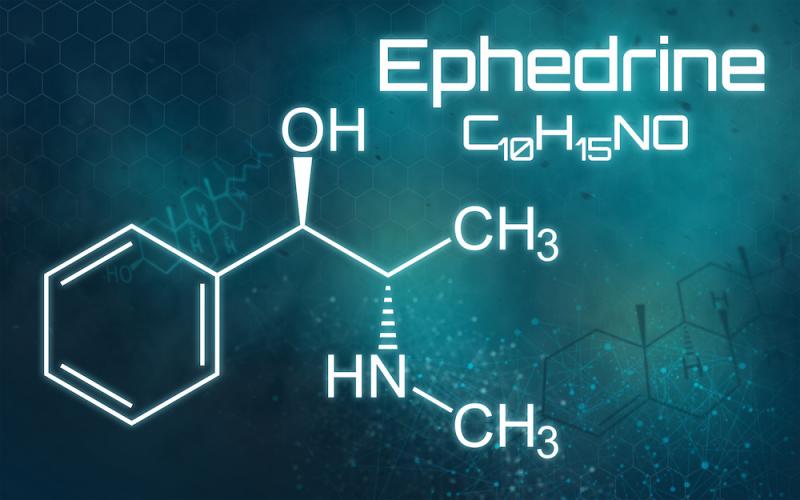
Ephedrine and Pseudoephedrine
When Western scientists discovered epinephrine, also known as adrenaline, they found it could be used to stop severe asthma attacks and allergic reactions. Epinephrine works by attaching to receptor sites in the sympathetic nervous system, the part of your nervous system that gets jacked up when feeling scared or stressed. The problem with epinephrine is that it has to be injected, which is how an EpiPen works. EpiPens are used to inject epinephrine into the bloodstream to counteract severe allergic reactions.
In searching for a way to administer epinephrine orally, they found the alkaloids ephedrine and pseudoephedrine in Chinese ephedra. These alkaloids are stable when taken orally and attach to the same receptors in the sympathetic nervous system, which means they act as stimulants, while also dilating the bronchioles and counteracting allergic reactions. Drug companies began using these isolated alkaloids in Western medicine for colds, allergies, and asthma. They are found in medicines like Sudafed, Contac, Actifed, Benadryl, Zertec, and numerous others.
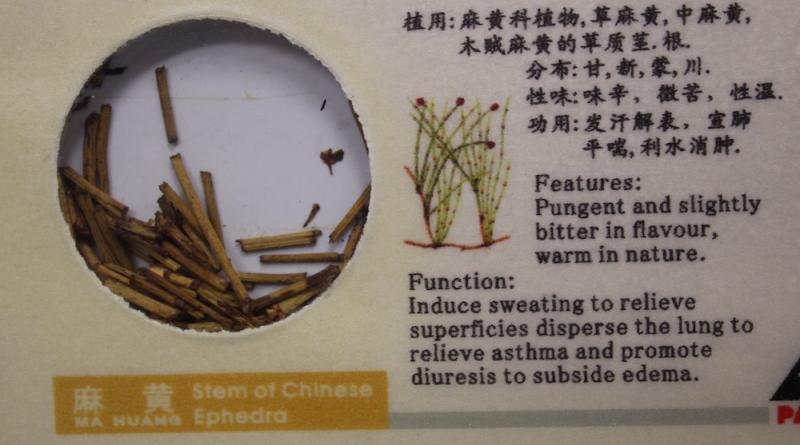
Chinese Ephedra and Amphetamines
Even though Chinese ephedra has been banned the many drugs that were derived from its isolated compounds are still available. According to the research I did about twenty years ago on the subject, many of the drugs known as amphetamines were actually created as synthetic analogs to epinephrine and pseudoephedrine, alkaloids found in Chinese ephedra. This includes the drug frequently prescribed for ADHD known as Ritalin.
I started learning about all of this when I ran a small herb company that made herbal glycerites. One of them was a glycerite of Chinese ephedra. One of our customers reported that he had been using it with his child who had ADHD instead of Ritalin. And while we tried it with other children with ADHD and found it worked as an alternative to Ritalin, I would still encourage people to look deeper and work on the underlying cause of ADHD and not just treat symptoms.
The Case for Western Ephedra
 Brigham tea is a great alternative to ma huang (Chinese ephedra). Like the Chinese used ma haung, the Native Americans used it to help with asthma, respiratory congestion, and the treatment of respiratory allergies.
Brigham tea is a great alternative to ma huang (Chinese ephedra). Like the Chinese used ma haung, the Native Americans used it to help with asthma, respiratory congestion, and the treatment of respiratory allergies.
It is a mild stimulant and it can help with chronic sinus congestion, allergic reactions, bronchitis, asthma, and even congestion in common colds. It also helps to open up the bronchial passages in conditions like asthma, bronchitis, and COPD. According to Michael More in Medicinal Plants of the Mountain West, “An acquaintance with a scourge of long-standing, yearly pollen allergies began drinking the tea as a regular beverage to replace coffee and found he had taken less than one-tenth of his usual number of little yellow allergy pills that season.”
While we don't know the exact reasons it works, Moore theorizes that it is because of the tannins or flavonoids Brigham tea contains or some other epinephrine-like alkaloids. Or perhaps it's a combination of things, as it is a whole plant that also has anti-inflammatory and diuretic properties.
Western ephedra is also a mildly stimulating, anti-inflammatory remedy similar in action to green tea. Having diuretic effects, it’s also used for urinary tract infections. In fact, it was once used as a treatment for syphilis, although I wouldn’t use it for that today. In addition, Michael Moore says it’s one of the highest herbal sources of calcium and can be used with other mineral-rich herbs such as nettles, oat straw, horsetail, and alfalfa to help build bones and other tissues.
So, why isn’t the herb industry using Brigham tea as a milder substitute for Chinese ephedra instead of extracts of bitter orange which contains a weaker epinephrine mimic known as synephrine? The reason why this perfectly legal herb isn’t being used more in the herb industry is a mystery to me. I can only guess that it is because as a society we're still possessed by the pursuit of the quick fix. And, while it is a great alternative, it is weaker in action than Chinese ephedra.
This is a shame because it is a great herb, and on top of everything else, it’s really a rather pleasant tea. David Christopher says that his father, the famous herbalist John Christopher, used to make popsicles out of the tea sweetened with a little honey and that they were delicious.
So, if you have respiratory problems like allergies, asthma, or chronic sinusitis, I’d definitely consider using Brigham tea. And it still makes a good substitute for coffee and caffeinated beverages as a pick-me-up for energy.
Steven's Articles
October
-

-
Understanding Caffeine & Cellular Adaptation
Preserving the power of caffeine's buzz and the…
September
-

-
Horseradish
A pungent spice for aiding protein metabolism…
-

-
Banaba or Crepe Myrtle
A beautiful tree from Southeast Asia whose leaves…
August
-

-
Monkeyflowers
Flower essences to help see ourselves more clearly…
-

-
Mariposa Lilies
Strengthening the bond between mother and child…
-

-
The Noble Bay Leaf
A common kitchen herb for aiding digestion and…
-

-
Epimedium: Horny Goat Weed
A circulatory stimulant and kidney yang tonic…
July
-

-
The Medicinal and Nutritional Benefits of Apricots
A nutritious fruit and valuable medicinal seed for coughs
-

-
Dogwoods
Asian dogwood is used to stop excessive discharge,…
June
-

-
Neem: The Village Pharmacy
A popular Ayurvedic remedy for dental and immune…
-

-
Spilanthes: The Toothache Plant
A traditional remedy for teeth and gums, as well…
-

-
Forsythia
An anti-inflammatory, fever-reducing, and infection fighting herb
May
-

-
Buckwheat (Kashi)
A delicious, high protein, gluten-free, gut-healthy food
-

-
Leaky Gut Syndrome
Plugging the leaks on the underlying cause of…
-

-
Storksbill
An edible, medicinal, weedy herb, helpful for…

